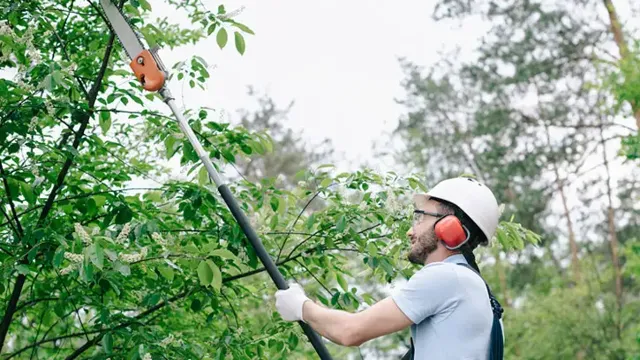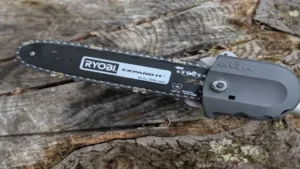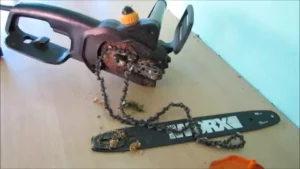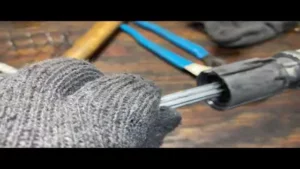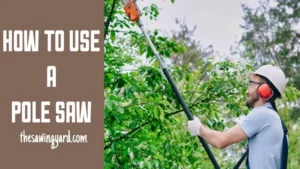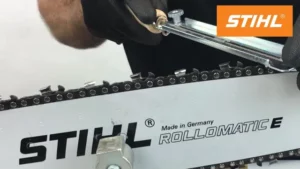Imagine looking up at the trees in your backyard and noticing a few different branches that need to be cut back. With a pole saw in hand, you can easily achieve this task without climbing a ladder. However, cutting limbs with a pole saw can be dangerous if not done correctly.
In this article, we’ll explore how to use a pole saw to safely cut limbs from trees. We’ll cover everything from selecting the right saw to choosing the appropriate technique to avoid any accidents. After reading this article, you’ll be equipped with all the knowledge you need to safely and efficiently trim your trees.
So grab your pole saw and let’s get started!
Equipment and Safety Precautions
Cutting limbs with a pole saw can be a great way to maintain trees and keep them healthy. However, it’s important to remember that this can be dangerous work, and it requires the right equipment and safety precautions. Before you start, make sure you have a sturdy pole saw that is long enough to reach the highest branches.
You should also wear protective gear, such as gloves, goggles, and a hard hat. Additionally, it’s important to check the area around the tree for obstacles and hazards, such as power lines or uneven ground. Always make sure your saw is in good working condition, and never use it if it’s damaged or broken.
Finally, it’s a good idea to have someone else with you while you’re working to provide assistance and keep an eye on safety. By taking these precautions, you can safely and effectively maintain your trees using a pole saw.
Check pole saw for defects and proper tension
When it comes to using a pole saw, it’s important to make sure the equipment is in good condition and properly adjusted. Before starting any work, you should thoroughly inspect the saw for any defects or damage. Make sure the blade is sharp and without any chips or cracks, as this could cause the saw to malfunction or kick back during use.
Additionally, check the tension of the blade and make sure it’s properly adjusted to the manufacturer’s specifications. Keeping the saw in good working condition is not only essential for your own safety, but it also helps you to efficiently and effectively complete the job at hand. So, take the time to inspect your saw before starting any pruning or cutting tasks.
By doing so, you’ll reduce the risk of accidents and ensure the best possible results.
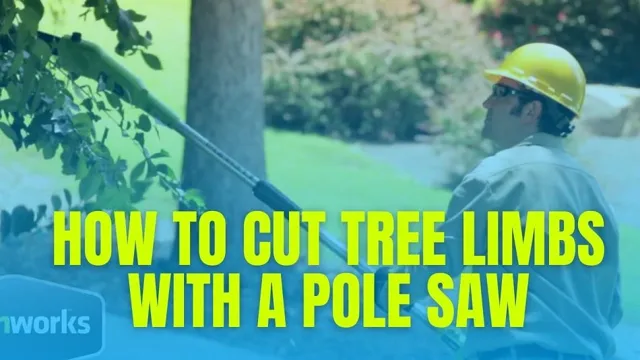
Inspect the blade sharpened and clean
When inspecting a blade that has been sharpened and cleaned, it’s essential to have the proper equipment and take safety precautions. The first thing to do is to make sure you have the right tools for the job. It’s important to have a pair of gloves to protect your hands from any potential cuts.
Additionally, a magnifying glass can help you see any imperfections in the blade’s edge that might have been missed during sharpening. Next, inspect the blade carefully, checking for any nicks or chips. If any are found, the blade should be re-sharpened and re-inspected.
Finally, make sure the blade is clean of any debris or metal filings that could cause damage to it during use. Overall, taking the time to inspect your blade before use will help ensure its longevity and your safety. Remember to always prioritize safety when working with sharp tools.
Wear safety gear, including a hardhat, gloves, and eye protection
As a responsible worker, it is essential to prioritize your safety when operating machinery or working in construction sites. One of the crucial safety precautions you must take is wearing the right protective gear, such as a hardhat, gloves, and eye protection. A hardhat protects your head from any falling debris or objects that may cause severe head injuries.
It also shields your face and neck from direct sunlight and rain, reducing the risk of skin damage and heatstroke. Gloves, on the other hand, provide protection to your hands from cuts, scratches, and chemical exposures. Lastly, eye protection safeguards your eyes from flying debris or bright lights, which may cause temporary or permanent vision loss.
Incorporating these safety gears into your work routine can significantly reduce the risk of injuries and ensure your safety. Therefore, always make sure to wear them even when it seems unnecessary. Remember, safety is always a top priority!
Selecting the Right Limb and Positioning Your Equipment
When it comes to cutting limbs with a pole saw, selecting the right limb and positioning your equipment is crucial for a successful cut. Start by identifying the limb you want to cut and checking for any obstacles or hazards that could get in the way. Once you have a clear path, choose the appropriate pole saw based on the height and thickness of the branch.
Position the saw so that the blade is perpendicular to the limb, and make sure the blade is facing away from you. It’s best to start cutting from the underside of the branch, about 3-4 inches away from the trunk. Use a steady and controlled motion until the branch falls away.
Remember to always prioritize safety, and never cut limbs that are too large or out of reach. By selecting the right limb and positioning your equipment correctly, you can ensure a smooth and efficient cut every time.
Identify the limb to be cut and assess its thickness
When selecting the limb to be cut, it’s crucial to assess its thickness to ensure that your equipment can handle it properly. This will help you avoid any mishaps or accidents during the process. Ideally, you want to select a limb that is thick enough to be sturdy and stable, but not so thick that your equipment struggles to make a clean cut.
Before making any cuts, take the time to identify the limb’s diameter and assess whether your equipment can handle it safely. It’s worth noting that the positioning of your equipment is just as important as selecting the right limb. You want to make sure that your saw or axe is positioned correctly so that you can make the cut cleanly and efficiently.
This might involve adjusting your position or the position of the limb itself to achieve the best angle and leverage. Always take your time to ensure that your body and equipment are positioned safely and comfortably before making any cuts. Overall, selecting the right limb and positioning your equipment are crucial steps in any tree cutting process.
By carefully assessing the thickness of the limb and adjusting your positioning as needed, you can ensure a safe and efficient cut every time. So, before you start cutting, take the time to evaluate the situation and make sure you’re approaching it in the best way possible.
Choose a safe and stable position
When it comes to selecting the right limb for your equipment, be sure to choose a safe and stable position. This means finding a sturdy, reliable branch that can support the weight of your gear without bending or breaking. Look for a limb that is thick, strong, and able to withstand the weight of your body as well as any tools you may be using.
Additionally, it is important to position your equipment in a way that is safe and secure. Avoid placing your gear near the edge of the limb, as this can increase the risk of a fall or accident. Instead, choose a position that is close to the trunk of the tree, where the limb is strongest and most stable.
By taking the time to choose the right limb and position your equipment correctly, you can prevent accidents and work more efficiently and effectively at height.
Position the pole saw at an angle for the most effective cut
When it comes to cutting limbs and branches with a pole saw, selecting the right limb and positioning your equipment is essential. First and foremost, you want to focus on the limbs that pose a potential danger to property or individuals. Ensure that these limbs are free from any objects, such as a wall or fence, that could interfere with your ability to make a smooth and safe cut.
Once you’ve selected your limb, you’ll want to position yourself and your equipment accordingly. To get the most effective cut, position the pole saw at an angle that allows you to make a clean cut with the least amount of effort. Remember to use the weight of the saw to your advantage, letting it do the work instead of forcing it.
By following these tips, you’ll be able to tackle any limb or branch with ease and confidence.
Making the Cut
If you’re wondering how to cut limbs with a pole saw, it’s important to first pick the right tool for the job. A pole saw is a long-handled saw with a blade at the end, designed for pruning high branches without the need for a ladder. Before you begin, make sure to wear the appropriate safety equipment such as gloves, goggles, and a hard hat.
Start by identifying the limb you want to remove, ensuring that it is safe to cut and won’t fall on any nearby structures or people. Then, use a sawing motion with the pole saw to slowly and carefully cut through the limb from the bottom up. Be sure to take frequent breaks and rest your arms to avoid fatigue and maintain precision.
With these tips and a little practice, you can efficiently and safely cut limbs with a pole saw to keep your trees healthy and beautiful.
Start with a light touch before increasing pressure
Making the cut in any field requires a delicate touch. Starting off cautiously before progressing to more intense pressure is a technique that can be incredibly effective. Whether you’re slicing through a piece of fruit or working on a more complex project, it’s important to take your time and gradually build up your confidence and skill.
This approach will help you to stay focused and avoid making mistakes that could result in frustration or setbacks. Remember, precision is key, and taking the time to fine-tune your technique will pay off in the long run. By mastering the art of making the cut, you’ll be one step closer to achieving your goals, both in your personal and professional life.
So start off light, build your skills, and watch as your hard work pays off in ways you never thought possible.
Use a back and forth sawing motion
When it comes to making a clean cut, it’s important to use the right technique. One of the most effective ways to saw through wood or other materials is to use a back and forth sawing motion. This involves moving the saw blade back and forth, applying consistent pressure to the material as you go.
By doing this, you’ll be able to get a smoother cut and prevent the saw blade from getting stuck or wobbling. It’s also important to choose the right saw for the job, as different types of saws are better suited to different materials. Whether you’re working with wood, metal, or plastic, a saw with the right type of teeth can make all the difference.
So the next time you need to make a cut, remember to use a back and forth sawing motion and choose the right saw for the job. With a little practice and patience, you’ll be able to master the art of cutting like a pro!
Stop cutting before the branch falls completely to avoid impact
When it comes to pruning or cutting a tree branch, it’s important to make sure it’s done correctly to avoid any potential damage. One important aspect to keep in mind is to stop cutting before the branch falls completely to avoid any impact. If you continue cutting until the very end, the weight of the branch could cause it to fall and potentially damage the trunk or other surrounding branches.
Instead, be sure to cut just before the branch breaks away naturally. This will ensure a clean cut and prevent any unwanted damage. By taking this small precaution, you can keep your trees healthy and thriving for years to come.
So, the next time you grab your pruning shears, remember to stop cutting before the branch falls completely for the best results.
Clear cut branches before moving on to the next one
When it comes to pruning trees, it’s important to remember the old adage: “clear cut branches before moving on to the next one.” This means making clean, precise cuts of each branch that you remove, rather than leaving rough stubs that can lead to disease and decay. Not only does this technique help keep your tree healthy, but it also ensures that you’ll achieve the desired shape and form.
When making a cut, use sharp, clean tools and make a smooth cut that leaves the collar intact. This collar is the raised ring of tissue at the base of each branch, which contains specialized cells that help the tree heal and defend against pests and pathogens. By making precise cuts and taking care to avoid damaging the collar, you can help your tree stay healthy and strong for years to come.
And remember, it’s always better to make several small cuts rather than one big one–so take your time and approach each branch with care. By focusing on making clean, precise cuts, you’ll help your tree thrive and give it the best chance for a long and healthy life.
Conclusion
In conclusion, if you want to cut limbs with a pole saw, there’s no need to be stumped. Just follow these simple steps: find the right tool for the job, make sure your work area is clear, and always put safety first. With a little bit of patience and practice, you’ll be branching out in no time.
So get out there and start trimming, because when it comes to pruning, the sky’s the limit!”
FAQs
What is a pole saw and how does it work?
A pole saw is a long-handled saw designed for cutting tree limbs and branches that are out of reach. It works by extending a long pole to reach higher branches and using a chainsaw or saw blade attached to the end to make the cut.
What type of blade is best for cutting limbs with a pole saw?
The type of blade you need for cutting limbs with a pole saw depends on the diameter and hardness of the branches you are cutting. Generally, a chainsaw blade is best for thicker limbs while a pruning saw blade is better suited for smaller and more delicate branches.
How high can a pole saw reach?
The maximum reach of a pole saw depends on the length of the pole and the operator’s height. Typically, a pole saw can reach between 10 to 15 feet, but there are also models that can extend up to 20 feet.
How do you use a pole saw safely?
To use a pole saw safely, wear protective gear such as eye and ear protection, gloves, and non-slip shoes. Always keep both hands on the saw and avoid overreaching. Make sure the saw is secure and stable before making any cuts.
Can a pole saw be used for pruning small branches?
Yes, a pole saw can be used for pruning small branches. In fact, many pole saws come with interchangeable pruning saw blades that are perfect for delicate pruning tasks.
What should you do if the pole saw blade gets stuck in a branch?
If the pole saw blade gets stuck in a branch, turn off the saw and wait until the blade stops moving before attempting to remove it. Do not attempt to force the saw or the branch as this could cause injury or damage to the saw.
How do you maintain a pole saw blade?
To maintain the pole saw blade, clean it regularly after each use with a damp cloth and lubricate it with oil to prevent rust and corrosion. Sharpen the blade as needed and replace it when it becomes dull or damaged.
